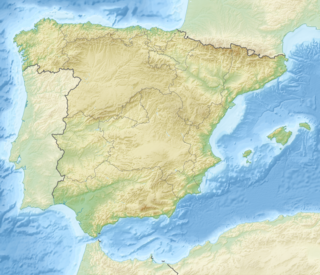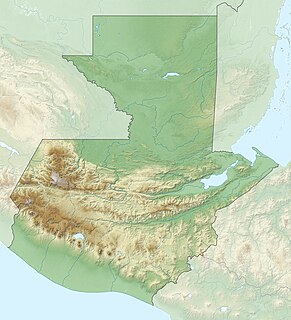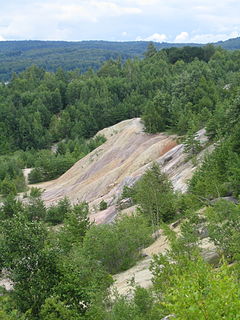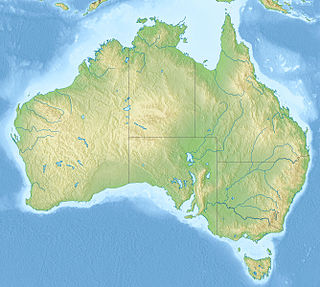 W
WThe Arén Formation or Arén Sandstone is a geological formation in the Tremp-Graus Basin around Arén, Catalonia, Spain whose strata date back to the Late Cretaceous. Dinosaur remains are among the fossils that have been recovered from the formation. The formation dates to the Campanian to Maastrichtian and underlies the Tremp Group.
 W
WThe Berivotra Formation is a Maastrichtian sedimentary formation of the Mahajanga Basin in Boeny, Madagascar. The claystones of the formation were deposited in a shallow marine environment. The Berivotra Formation overlies the fossil-rich Maevarano Formation, in which more fossils of Beelzebufo, also recovered from the Berivotra Formation, have been found. Many shark and ray teeth were collected by surface prospecting on outcrops of the Berivotra Formation, which is readily distinguished by its yellowish grey to pale olive colour, as opposed to the white and green fluvial sandstones that form the upper 15 to 20 metres of the underlying Maevarano Formation.
 W
WThe Calizas de Lychnus Formation is a Maastrichtian geologic formation in northern central Spain. Dinosaur remains diagnostic to the genus level are among the fossils that have been recovered from the formation.
 W
WThe Conway Formation is a Campanian to Danian geologic formation in the South Island of New Zealand and therefore crosses the Cretaceous–Paleogene boundary. Plesiosaur remains are among the fossils that have been recovered from its strata. The Conway Formation is part of the Eyre Group and Haerenga Supergroup.
 W
WThe Dalangshan Formation, also referred to as the Dalangshan Group is a geological formation in the Sanshui District of Guangdong Province, China, the strata of which date back to the Late Cretaceous period.
 W
WThe Dukamaje Formation is a geological formation in Niger whose strata date back to the Late Cretaceous. Dinosaur remains are among the fossils that have been recovered from the formation. A wealth of Mosasaur fossils have also been recovered from this formation, particularly from the area around Mt. Igdaman.
 W
WThe Eginsai Formation is a geological formation in Kazakhstan whose strata date back to the Late Cretaceous. Dinosaur remains are among the fossils that have been recovered from the formation.
 W
WThe Gosau Group is a geological stratigraphic group in Austria, Germany and western Slovakia whose strata date back to the Late Cretaceous to Eocene. It is exposed in numerous sporadic isolated basins within the Northern Calcareous Alps. It is divided into two subgroups, the Lower Gosau Subgroup which dates from the Turonian to Campanian, approximately 90 to 75 Ma and the Upper Gosau Subgroup which dates to the Santonian to Eocene, about 83.5 to 50 Ma. The formations within each subunit vary significantly between basins. The sequence is largely marine, but the Grünbach Formation represents a terrestrial deposit. Many of the units of the group are fossiliferous, typically providing marine fossils such as ammonites, though terrestrial remains including those of dinosaurs are known from the Grünbach Formation and Schönleiten Formation.
 W
WArgiles et Grès à Reptiles Formation, also known as the Argiles Rutilantes Formation is an early Maastrichtian French geologic formation in the département of Var preserving the remains of several types of dinosaurs and other extinct organisms.
 W
WThe Ixcoy Formation is a geologic formation in Guatemala. It preserves fossils dating back to the Cretaceous period. The upper part of the Ixcoy Formation is laterally equivalent with the Campur Formation of the Petén Basin in northern Guatemala.
 W
WThe Kakanaut Formation is a geological formation in Siberia, whose strata date back to the Late Cretaceous (Maastrichtian). Dinosaur remains are among the fossils that have been recovered from the formation. The youngest remains of Bennettitales in the northern hemisphere, Pterophyllum terechoviae are known from the formation.
 W
WThe Kallakurichi Formation, alternatively spelled as Kallankurichchi or Kallankurichi Formation, is a geological formation of the Ariyalur Group in Tamil Nadu, southern India whose strata date back to the Maastrichtian stage of the Late Cretaceous. Dinosaur eggs of Megaloolithus cylindricus are among the fossils that have been recovered from the sandy limestones of the formation.
 W
WThe Katiki Formation is a Late Cretaceous geologic formation of the South Island of New Zealand. Plesiosaur remains of Kaiwhekea katiki, named after the formation, are among the fossils that have been recovered from the deltaic siltstones.
 W
WThe Kristianstad Basin is a Cretaceous-age structural basin and geological formation in northeastern Skåne, the southernmost province of Sweden. The basin extends from Hanöbukten, a bay in the Baltic Sea, in the east to the town of Hässleholm in the west and ends with the two horsts Linderödsåsen and Nävlingeåsen in the south. The basin's northern boundary is more diffuse and there are several outlying portions of Cretaceous-age sediments. During the Cretaceous, the region was a shallow subtropical to temperate inland sea and archipelago.
 W
WThe Lameta Formation, also known as the Infratrappean Beds is a sedimentary rock formation found in Madhya Pradesh, Gujarat, and Maharashtra, India. It is of Maastrichtian age, and is notable for its dinosaur fossils. Many dubious names have been created for isolated bones, but several genera of dinosaurs from these rocks are well-supported, including the titanosaur sauropod Isisaurus and the abelisaurs Indosaurus, Indosuchus, Laevisuchus, and Rajasaurus. As well as mammals, snakes and other fossils.
 W
WThe Lapurr Sandstone, also spelled Lapur Sandstone, previously considered part of the informal "Turkana Grits", is a geological formation in Kenya. It is the oldest unit in the Turkana Basin. The strata date back to the Late Cretaceous, likely Campanian to Maastrichtian, based on palynology and the presence of dyrosaurs and mosasaurs, the upper part of the unit likely extends into the Palaeogene, based on zircon dating. It predominantly consists of fine-coarse arkosic sandstone, which has been interpreted as either been deposited in fluvial or shallow marine conditions. Dinosaur remains among other vertebrates have been recovered from it around Lokitaung Gorge, though these mostly consist of heavily abraded, isolated bones of robust morphology like sauropod limb bones and caudal vertebrae.
 W
WThe Lopez de Bertodano Formation is a geological formation in the James Ross archipelago of the Antarctic Peninsula. The strata date from the end of the Late Cretaceous to the Danian stage of the lower Paleocene, from about 70 to 65.5 million years ago, straddling the Cretaceous-Paleogene boundary.
 W
WThe Maastricht Formation, named after the city of Maastricht, the Netherlands, is a geological formation in the Netherlands and Belgium whose strata date back to the Late Cretaceous, within 500,000 years of the Cretaceous–Paleogene boundary, now dated at 66 million years ago. The formation is part of the Chalk Group and is between 30 and 90 metres thick. It crops out in southern parts of Dutch and Belgian Limburg and adjacent areas in Germany. It can be found in the subsurface of northern Belgium and southeastern Netherlands, especially in the Campine Basin and Roer Valley Graben. Dinosaur remains are among the fossils that have been recovered from the formation.
 W
WThe Maevarano Formation is a Late Cretaceous sedimentary rock formation found in the Mahajanga Province of northwestern Madagascar. It is most likely Maastrichtian in age, and records a seasonal, semiarid environment with rivers that had greatly varying discharges. Notable animal fossils recovered include the theropod dinosaur Majungasaurus, the early bird Vorona, the flying dromaeosaur Rahonavis, the titanosaurian sauropod Rapetosaurus, and the giant frog Beelzebufo.
 W
WThe Marnes d’Auzas Formation is a geological Formation in southwestern France whose strata date back to the Late Maastrichtian. It is about 100 metres thick and consists primarily of marls with some interbeds of sandstones. It corresponds to sediments whose depositional environment evolved from the paralic domain at the base of the formation, towards a more continental domain in its upper part. The Marnes d’Auzas Formation was deposited in the west coast of the former Ibero-Armorican Island, which included much of France and Spain.
 W
WThe Marnes Rouges Inferieures Formation is a Late Cretaceous geologic formation found in the French Pyrenees. It predominantly consists of red mustone, with minor brown mudstone and sandstone. Dinosaurs, dinosaur eggs and avialian stem-birds have been reported from the formation.
 W
WThe Miria Formation is a Late Cretaceous geologic formation. Possible indeterminate theropod remains have been recovered from it, as well as those of sea turtles, and possible azhdarchid pterosaurs. The lithology of the unit consists of calcarenite with abundant phosphatic nodules.
 W
WThe Mishash Formation is a Late Cretaceous (Campanian-Maastrichtian) geologic formation in Israel. The formation is correlated with the Duwi Formation of Egypt and the Amman and Ruseifa Formations of Jordan. Mosasaur fossils assigned to Prognathodon currii and pterosaur fossils have been recovered from the formation.
 W
WThe Nanxiong Formation is a Late Cretaceous geologic formation in Guangdong Province. Dinosaur remains are among the fossils that have been recovered from the formation. It consists of continental siliciclastic red beds, with fauna which similar to that of the Nemegt Formation. It has been dated about 66.7 ± 0.3 million years ago. It is the lowest unit of the Nanxiong Basin, a small graben created during Mesozoic rifting. Buck et al. state that it overlies Jurassic granite basement, and is conformably overlain by the Shanghu Formation. Alternative stratigraphic schemes for the Nanxiong basin have been proposed, one of which refers to the Nanxiong succession as the Nanxiong Group, and dividing it into the Yuanfu, Zhutian and Zhenshui formations, and overlying the Albian to Turonian Changba Formation.
 W
WThe Qiupa Formation is a Late Cretaceous Maastrichtian geologic formation in Henan Province, central China. It is rich in dinosaur eggs and bones, such as those of carnivorous and herbivorous dinosaurs. The Qiupa Formation is considered to be Late Maastrichtian in age, about 72 million and 66 million years ago.
 W
WThe Sânpetru Formation is a early Maastrichtian geologic formation. Dinosaur remains are among the fossils that have been recovered from the formation. It is located in Romania, near Sânpetru village, part of Sântămăria-Orlea commune. It forms a component of the Hațeg Island fauna.
 W
WThe Shendi Formation is a Late Cretaceous geologic formation of the Atbara-Shendi Basin in northern Sudan. Indeterminate theropod remains have been recovered from it. As well as those of the dyrosaurid Hyposaurus. It consists of a lower unit of fine grained meandering channel sediments, separated by an erosive contact with overlying meandering to braided river channel sandstones.
 W
WThe Sierra Perenchiza Formation is a late Campanian to late Maastrichtian geologic formation in Spain. Dinosaur remains are among the fossils that have been recovered from the formation, although none have yet been referred to a specific genus.
 W
WThe Subashi Formation is a Late Cretaceous formation from the Xinjiang Autonomous Region of western China. Initially described by Dong Zhiming in 1977, the formation contains remains of Tarbosaurus which were initially described as a separate taxon Shanshanosaurus huoyanshanensis. Remains of a sauropod, likely Nemegtosaurus, and a hadrosaurid, likely Jaxartosaurus, have also been found.
 W
WThe Takli Formation is a Maastrichtian geologic formation in India. Dinosaur remains diagnostic to the genus level are among the fossils that have been recovered from the formation.
 W
WThe Tremp Formation, alternatively described as Tremp Group, is a geological formation in the comarca Pallars Jussà, Lleida, Spain. The formation is restricted to the Tremp or Tremp-Graus Basin, a piggyback foreland basin in the Catalonian Pre-Pyrenees. The formation dates to the Maastrichtian to Thanetian, thus the formation includes the Cretaceous-Paleogene boundary that has been well studied in the area, using paleomagnetism and carbon and oxygen isotopes. The formation comprises several lithologies, from sandstone, conglomerates and shales to marls, siltstones, limestones and lignite and gypsum beds and ranges between 250 and 800 metres in thickness. The Tremp Formation was deposited in a continental to marginally marine fluvial-lacustrine environment characterized by estuarine to deltaic settings.
 W
WThe Udurchukan Formation is a geological formation located in Amur Region, Far East Russia. Based on palynomorphs such as Wodehouseia spinata the Udurchukan is considered of Maastrichtian age of the Late Cretaceous, during the Cretaceous Period.
 W
WThe Villalba de la Sierra Formation is a Campanian to Maastrichtian geologic formation in Spain. Fossil dinosaur eggs have been reported from the formation, that comprises gypsiferous, grey, argillaceous mudstones and sandstones, deposited in a floodplain environment. Abundant titanosaurian remains, including Lohuecotitan were found in the formation. More than 10,000 fossil remains of various fishes, amphibians, lizards, dinosaurs, turtles, and crocodiles are also known from the site, one of the richest for the Late Cretaceous in Europe.
 W
WThe Wadi Milk Formation is a geological formation in Sudan whose strata date back to the Late Cretaceous. Originally, the formation was thought to be Albian to Cenomanian, later research has provided dating to the Campanian to Maastrichtian. Dinosaur remains are among the fossils that have been recovered from the formation. It stretches from the lower Wadi Al-Malik across the Wadi Muqaddam into the Bayuda Desert.